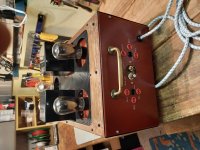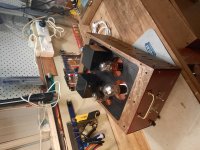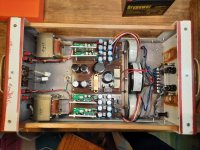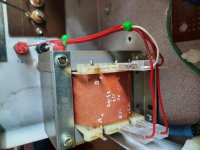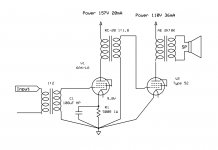Every valve is well over 80 years old. The rectifier is a cold cathode Raytheon BH circa 1929, the input valves are Raytheon LA pentodes configured as triodes, circa 1931. The output valves are 1933 Raytheon type 52 dual grid power triodes operating into 2kOhm and biased at .... 0V. Shades of Motorola car audio circa 1933 ....
Transformer input (might yet change to RC 'cos I think the wee thing's having trouble with low frequencies) to the trioded LAs biased at -9V 20mA and 175V, transformer coupled with Softone RC-20s to the type 52s each drawing 35mA at 100V Vak. OPTs by AE Europe, regs from Rod Coleman, HT is CRCRCLCRC in which the L is a common mode choke courtesy of Dave Slagle.
Playing now into 10" drivers. A fun Covid19 lock-down project 🙂
Transformer input (might yet change to RC 'cos I think the wee thing's having trouble with low frequencies) to the trioded LAs biased at -9V 20mA and 175V, transformer coupled with Softone RC-20s to the type 52s each drawing 35mA at 100V Vak. OPTs by AE Europe, regs from Rod Coleman, HT is CRCRCLCRC in which the L is a common mode choke courtesy of Dave Slagle.
Playing now into 10" drivers. A fun Covid19 lock-down project 🙂
Attachments
How does it sound? Well, very very little hum at the speakers - sensible layout and Rod Coleman's regs make sure of that. Some very very low level valve "flicker" or "fluff" - a hint of microphony to come perhaps?
Nice mid-range and highs - doesn't sound softened or rolled off. Playing John Adams' "I was looking at the ceiling and then I saw the sky" delivers excellent instruments and voices. All the low level stuff is there - even gentle bass. Bass. Aha - microphony starts fuzzying things up and yep, it's the globe LAs. And maybe the input transformer too.
I'll listen for a few more days (or maybe weeks - it's quite nice in my small workroom) and then will probably put it on the bench to measure it. I'm expecting 1Watt for 2% THD. I'm expecting highs out to 25kHz and bass to start wobbling from 80Hz down. I will be pleased if all that pans out. 🙂
Nice mid-range and highs - doesn't sound softened or rolled off. Playing John Adams' "I was looking at the ceiling and then I saw the sky" delivers excellent instruments and voices. All the low level stuff is there - even gentle bass. Bass. Aha - microphony starts fuzzying things up and yep, it's the globe LAs. And maybe the input transformer too.
I'll listen for a few more days (or maybe weeks - it's quite nice in my small workroom) and then will probably put it on the bench to measure it. I'm expecting 1Watt for 2% THD. I'm expecting highs out to 25kHz and bass to start wobbling from 80Hz down. I will be pleased if all that pans out. 🙂
bondini,
Very nice work, looks beautiful!
I could not find any information on a Raytheon dual grid Triode type 52 tube.
Is the tube a VT52, a special 45 type tube?
Thanks!
Very nice work, looks beautiful!
I could not find any information on a Raytheon dual grid Triode type 52 tube.
Is the tube a VT52, a special 45 type tube?
Thanks!
Type 52 data
Franks manufacturer data includes the 1937 Raytheon "Databook" top of the list here: electron Tube Data sheets - Raytheon documents The Type 52 is toward the back.
Terman gives a general description of dual grid triodes page 147 of Radio Engineering (2nd ed, 1937). Lud Sibley is more specific in his Tube Lore II:
The LA and the 52 were both made with 6.3V filaments designed to be fed from batteries. The type 52 was intended for Class B use in car radios - hence my reference to Motorola car radio at the beginning of the thread - or Class A for home radio sets.
Raytheon introduced the LA in March 1932 for use in car radio and it was in the circuit for the Motorola 's 1931-32 car radio line-up. Most were made with the ST-14 bulb and were marked 6A4/LA or 6A4 (even though it was never RMA registered). It was superseded by types 41 and 42, which could take 250 V on the plate and were less sensitive to variations in battery voltage. Considered an obsolete type, the War Production Board ordered manufacturing to stop in 1942. There was some post-1948 production when RCA could buy it in from nowhere else.
As a result, 6A4/LAs and type 52s are orphan stock, left on car dealers' shelves, some still available NOS. My first samples turned up in a big cardboard box at a car-park market in Wagga Wagga in 2001 ...
Franks manufacturer data includes the 1937 Raytheon "Databook" top of the list here: electron Tube Data sheets - Raytheon documents The Type 52 is toward the back.
Terman gives a general description of dual grid triodes page 147 of Radio Engineering (2nd ed, 1937). Lud Sibley is more specific in his Tube Lore II:
The double-grid feature uses two grids tied together to get a high mu without using a delicate close spacing between the first grid and the filament - a technique also used in types 46 and 49.
The LA and the 52 were both made with 6.3V filaments designed to be fed from batteries. The type 52 was intended for Class B use in car radios - hence my reference to Motorola car radio at the beginning of the thread - or Class A for home radio sets.
Raytheon introduced the LA in March 1932 for use in car radio and it was in the circuit for the Motorola 's 1931-32 car radio line-up. Most were made with the ST-14 bulb and were marked 6A4/LA or 6A4 (even though it was never RMA registered). It was superseded by types 41 and 42, which could take 250 V on the plate and were less sensitive to variations in battery voltage. Considered an obsolete type, the War Production Board ordered manufacturing to stop in 1942. There was some post-1948 production when RCA could buy it in from nowhere else.
As a result, 6A4/LAs and type 52s are orphan stock, left on car dealers' shelves, some still available NOS. My first samples turned up in a big cardboard box at a car-park market in Wagga Wagga in 2001 ...
Last edited:
I'd be interested in the schematic? I was wondering what the considerations are when selecting an interstage transformer. I have a few tubes that have curves for positive grid voltages, and I have heard of people getting good results with old Philips transformers from radios with 800ohm speakers.
Nice, I like that you located the power transformer to the front of the chassis, most people put it in the rear which puts it close to the input jacks and OPT's. Makes sense if you have room in the front for it.
- Home
- Amplifiers
- Tubes / Valves
- The Octogenarian - SE DHT Class A2
